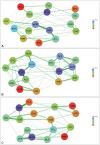Network Structure of Depression and Anxiety Symptoms in Older Asian Patients With Depressive Disorders: Findings From REAP-AD3
- PMID: 40404385
- PMCID: PMC12104763
- DOI: 10.30773/pi.2025.0033
Network Structure of Depression and Anxiety Symptoms in Older Asian Patients With Depressive Disorders: Findings From REAP-AD3
Abstract
Objective: The clinical presentation of depressive disorders might be influenced by age, and its diagnosis and treatment can be affected by ageism-related bias. A network analysis can reveal symptom patterns unrecognized by the reductionistic approach. Therefore, this study explores the network structure of depression and anxiety symptoms in older Asian patients with depressive disorders and examines age-related differences in the context of ageism.
Methods: We used data from the Research on Asian Psychotropic Prescription Patterns for Antidepressants, Phase 3 study and included 2,785 psychiatric patients from 11 Asian countries. Depression and anxiety symptoms were assessed using the Patient Health Questionnaire-9 and Generalized Anxiety Disorder-7. Network analyses were conducted to identify symptom interconnections and centrality among older (>65 years), middle-aged (35-64 years), and young (18-34 years) adult groups. The network structures were also compared using a network comparison test.
Results: Depressed mood was the most central symptom across all age groups. Network comparisons revealed no significant structural differences among the three age groups, despite several variations in terms of global strength. The network structure of the older group was characterized by strong interconnections between somatic symptoms (insomnia-energy) and core depressive symptoms (little interest or pleasure-feelings of hopelessness).
Conclusion: This study reveals that the network structures of depression and anxiety symptoms have relatively consistent interconnections across age groups, despite subtle age-based differences. Specifically, older adults tend to present anxiety and depression symptoms as physical complaints. These findings challenge ageist stereotypes and advocate for inclusive, age-neutral approaches to treatment.
Keywords: Age; Ageism; Anxiety; Asian patients; Depression; Network analysis.
Conflict of interest statement
Seon-Cheol Park and Norman Sartorius, contributing editors of
Figures


Similar articles
-
Network analysis of the depressive symptom profiles in Asian patients with depressive disorders: Findings from the Research on Asian Psychotropic Prescription Patterns for Antidepressants (REAP-AD).Psychiatry Clin Neurosci. 2020 Jun;74(6):344-353. doi: 10.1111/pcn.12989. Epub 2020 Mar 5. Psychiatry Clin Neurosci. 2020. PMID: 32048773 Free PMC article.
-
Letter to the Editor: CONVERGENCES AND DIVERGENCES IN THE ICD-11 VS. DSM-5 CLASSIFICATION OF MOOD DISORDERS.Turk Psikiyatri Derg. 2021;32(4):293-295. doi: 10.5080/u26899. Turk Psikiyatri Derg. 2021. PMID: 34964106 English, Turkish.
-
Interpersonal symptoms in adolescence depression across Asian and European regions: a network approach.BMC Psychiatry. 2024 Oct 22;24(1):713. doi: 10.1186/s12888-024-06161-9. BMC Psychiatry. 2024. PMID: 39438881 Free PMC article.
-
Behavioural modification interventions for medically unexplained symptoms in primary care: systematic reviews and economic evaluation.Health Technol Assess. 2020 Sep;24(46):1-490. doi: 10.3310/hta24460. Health Technol Assess. 2020. PMID: 32975190 Free PMC article.
-
A network model of depressive and anxiety symptoms: a statistical evaluation.Mol Psychiatry. 2024 Mar;29(3):767-781. doi: 10.1038/s41380-023-02369-5. Epub 2024 Jan 18. Mol Psychiatry. 2024. PMID: 38238548 Free PMC article.
References
-
- Lichtenberg P, Belmaker RH. Subtyping major depressive disorder. Psychother Psychosom. 2010;79:131–135. - PubMed
-
- Husain MM, Rush AJ, Sackeim HA, Wisniewski SR, McClintock SM, Craven N, et al. Age-related characteristics of depression: a preliminary STAR*D report. Am J Geriatr Psychiatry. 2005;13:852–860. - PubMed
Grants and funding
LinkOut - more resources
Full Text Sources

